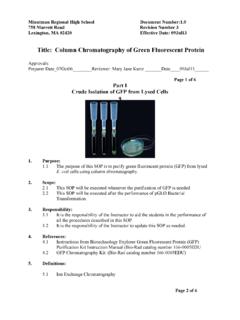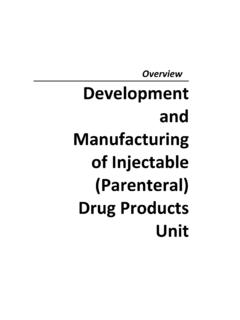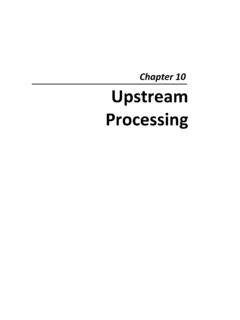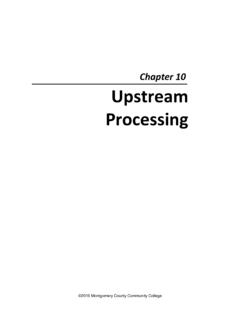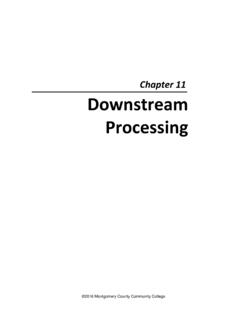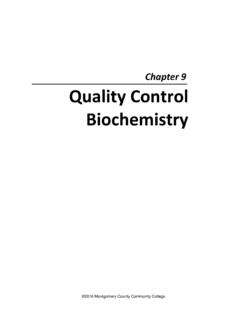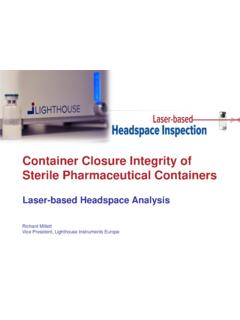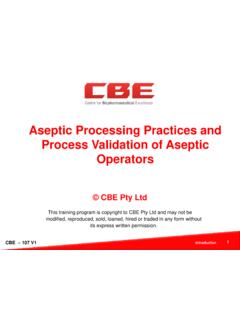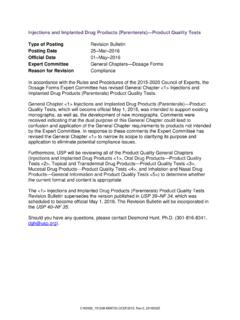Transcription of Chapter 14 Sterile Filtration, Filling, and Lyophilization ...
1 2016 Montgomery County Community College Chapter 14 Sterile filtration , Filling, and Lyophilization of Product 2 Chapter 14 Sterile filtration , Filling, and Lyophilization of Product Objectives This Chapter provides both an opportunity to identify the purpose of filtration in pharmaceutical applications as well as an overview of typical methods used in filling pharmaceutical products, focusing on parenteral manufacturing. This Chapter also provides an overview of Lyophilization , or freeze-drying, which is a way to increase the shelf life of certain products that are unstable in the solution state.
2 Freeze-drying can also be used to reduce the weight of certain materials for easier transportation. The Chapter begins with a brief introduction to the principles and history of freeze-drying, followed by the different systems utilized in modern freeze-dryers. The Lyophilization properties of different materials typically used; the different phases of the freeze-drying process; and how optimized Lyophilization cycles are designed are all addressed in this Chapter . Finally, the Chapter will conclude with the manufacturing of lyophilized products and the processes used to test for residual moisture.
3 After completing this Chapter the student will be able to: explain filter validation, bacterial retention, extractables, and compatibility. explain filter integrity testing. define the physical properties of different materials and how they freeze-dry. identify the different components that make up a modern freeze-dryer. discuss the different phases of a Lyophilization process. explain the modern manufacturing process for producing freeze-dried products. define the importance of and understand the different ways that residual water is measured.
4 Introduction to Biomanufacturing 3 Terms m: m equals inches (a human hair is 40 to 120 m thick) Amorphous systems: solids were molecules form a solid in complete disarray; the structure is held together as a highly viscous system with no bonds being formed between the molecules. Ampoule: a sealed glass or plastic bulb containing solutions for hypodermic injection; ampoules are the least expensive form of pharmaceutical packaging; common in third world and many veterinary applications. Aseptic: 1) without (free of) disease-causing microorganisms 2) preventing infection.
5 Designed to prevent infection from pathogenic microorganisms Aseptic processing: the process by which a Sterile product (typically pharmaceutical ) is packaged in a Sterile container in a way that maintains sterility Automated Filter Integrity Testing (AFT): an instrument that performs the typical integrity tests used in pharmaceutical manufacturing ( , bubble point, diffusive flow, pressure hold, and water intrusion) Bacterial retention: validation that confirms the filter membrane s ability to produce a Sterile effluent when exposed to a pharmaceutical product with 107 CFU of B.
6 Diminuta per cm2 Capacitance manometer: a gauge that measures vacuum; this gauge senses changes in pressure by using a fluctuating metal diaphragm; this device is a capacitor, and the capacitance is directly proportional to the dielectric current of the medium relative to that of air and to a geometry factor; in normal operation of a capacitor, the geometry factor is held constant, and the dielectric constant is varied; for the purpose of freeze-drying the opposite is true; the thin metal diaphragm is sealed between two fixed electrodes; the reference side of the device is sealed and a small vacuum is created; the other side is open to the Lyophilization chamber; as a vacuum is created in the freeze-dryer, the diaphragm stretches (changes geometry), and the capacitance change results in a change in voltage, which is correlated back to pressure on the readout.
7 These types of sensors are not thrown off of set point by water vapor like the Pirani gauges, so they are reading accurate vacuum values during the entire cycle regardless of the type of gas present. Colony Forming Unit (CFU): an estimate of microbial numbers (microbial cells rarely exist as single cells , streptococcus-chains, staphylococcus-clumps) forming a discrete colony container /closure system: refers to the sum of packaging components that together contain and protect the drug dosage form Crystalline systems: solids where molecules line up in a precise pattern known as a crystalline lattice; chemical bonds and other attractive forces hold the structure together.
8 Differential Scanning Calorimetry (DSC): an analytical instrument used to determine, among other things, the eutectic melting and glass transition temperatures of a frozen solid 4 Chapter 14 Sterile filtration , Filling, and Lyophilization of Product Eutectic: two or more crystalline species in such close contact that they melt as a single, pure substance Eutectic melt: the characteristic temperature where a eutectic solid melts Flexible IV (intravenous) bags: a Sterile bag used to hold fluids that are administered to a patient intravenously (in the veins); these fluids can be anything from mixtures of medicines, to blood for a blood transfusion, to saline for hydration.
9 Freeze-drying ( Lyophilization ): the process of removing water, or other solvent, from a frozen matrix by converting the water directly from a solid phase (ice) to a vapor phase under high vacuum through a process known as sublimation Glass transition temperature: the temperature where a solid, glassy phase begins to melt Glassy phase: an amorphous solid Hydrophilic: water loving; spontaneously wets when exposed to water. Hydrophobic: water hating; does not spontaneously wet when exposed to water. Integrity testing: a non-destructive method of checking for defects in a filter membrane; an integral filter has the ability of removing bacteria from a solution (linked to bacterial retention).
10 Karl Fischer: a method used to test for residual moisture (volumetric or coulometric) Metastable systems: a solid phase that formed as an amorphous phase on freezing when it should have formed a eutectic phase Near Infrared Spectroscopy (NIR): the wavelengths of electromagnetic radiation between 800 and 2500 nm; an alternative technique used to measure residual moisture in lyophilized products. Parenteral: not through the alimentary canal but rather by injection through some other route, such as subcutaneous or intramuscular Pirani gauge: a gauge designed to measure vacuum; a wire in the gauge is heated to a certain temperature and exposed to a vacuum in a chamber; at atmospheric pressure there are many molecules in the ambient air that strike the surface of the heated wire and carry away some heat; it requires more energy to keep the wire heated to the same temperature at atmospheric pressure.
